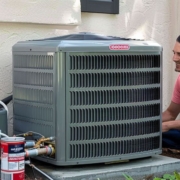What Does “Dry” Mean on AC?
Have you ever glanced at your air conditioner’s remote control and noticed a mode labelled “Dry” and wondered what it does? Understanding this function can help optimize AC usage and maintain a comfortable indoor environment. In this article, we’ll delve into the intricacies of the “Dry” mode on your air conditioner, explaining its purpose, benefits, and how to make the most of it.
Introduction to AC Dry Mode
Modern air conditioners have various modes designed to cater to different preferences and environmental conditions. One such mode is the “Dry” mode, often represented by a symbol resembling a water droplet. While it might seem puzzling at first glance, this mode serves a crucial purpose in regulating indoor humidity levels.
How Does Dry Mode Work?
Activating the “Dry” mode on your air conditioner operates differently from the standard cooling mode. Instead of solely focusing on lowering the temperature, the AC prioritizes dehumidification. It achieves this by running the compressor at a lower speed, allowing it to remove excess moisture from the air without significantly reducing the temperature.
Benefits of Using Dry Mode
Improved Air Quality
The “Dry” mode helps improve indoor air quality by reducing humidity levels. High humidity can create an ideal environment for mould, mildew, and dust mites to thrive, contributing to respiratory issues and allergies. Regularly using the “Dry” mode can mitigate these risks and create a healthier living space.
Reduced Humidity Levels
Excessive humidity makes the air feel muggy and makes it harder for your body to regulate temperature through sweat evaporation. By removing moisture from the air, the “Dry” mode enhances comfort by creating a drier environment.
Preventing Mold and Mildew Growth
Humidity is a leading cause of mould and mildew growth, especially in areas with poor ventilation. By keeping humidity levels in check, the “Dry” mode helps prevent the formation of these harmful substances, protecting your home and health.
When Should You Use Dry Mode?
Knowing when to activate the “Dry” mode can maximize its effectiveness in maintaining a comfortable indoor environment.
During Humid Weather
During hot and humid weather, activating the “Dry” mode can help alleviate discomfort caused by sticky air and excessive sweating.
After Cooking or Showering
Activities like cooking and showering can release moisture into the air, raising humidity levels in your home. After such activities, the “Dry” mode can help restore a balanced environment.
When You Notice Condensation
Condensation on windows, walls, or surfaces clearly indicates high humidity levels. Running the AC in “Dry” mode can help eliminate condensation and prevent water damage.
How to Activate Dry Mode
Activating the “Dry” mode on your air conditioner is typically straightforward. Consult your AC’s user manual or follow these general steps:
- Press the “Mode” button on your remote control until you reach the “Dry” mode.
- Adjust the temperature settings if necessary.
- Press the “Power” button to start the AC in “Dry” mode.
Understanding the “Dry” Symbol on Your AC
The “Dry” symbol on your air conditioner’s remote control usually resembles a water droplet or a raindrop. Familiarizing yourself with this symbol ensures you can quickly identify and utilize the “Dry” mode when needed.
Common Misconceptions About Dry Mode
Despite its benefits, some misconceptions surround the “Dry” mode on air conditioners.
Confusion with Cooling Mode
Some users mistake the “Dry” mode for the cooling mode and expect it to lower the temperature significantly. It’s essential to understand that the primary function of the “Dry” mode is dehumidification, not cooling.
Belief That Dry Mode Consumes More Energy
Contrary to popular belief, the “Dry” mode typically consumes less energy than the cooling mode since it runs the compressor at a lower speed. Using the “Dry” mode strategically can help reduce overall energy consumption.
Maintenance Tips for Dry Mode
To ensure optimal performance of the “Dry” mode and your air conditioner in general, consider the following maintenance tips:
- Cleaning Air Filters Regularly: Clogged air filters can obstruct airflow and reduce the efficiency of the “Dry” mode. Clean or replace the filters according to the manufacturer’s recommendations.
- Checking for Drainage Issues: Ensure the AC’s drainage system is clear of obstructions to prevent water buildup and potential damage to the unit.
Conclusion
Understanding the function and benefits of the “Dry” mode on your air conditioner can help you create a more comfortable and healthy indoor environment. By utilizing this mode strategically and maintaining your AC correctly, you can enjoy improved air quality, reduced humidity levels, and greater energy efficiency.
FAQs (Frequently Asked Questions)
- Does the “Dry” mode cool the room like the standard cooling?
- No, the primary function of the “Dry” mode is to dehumidify the air rather than lower the temperature significantly.
- Can I use the “Dry” mode with other modes like cooling or heating?
- You can combine the “Dry” mode with other modes based on your preferences and comfort needs.
- How often should I use the “Dry” mode?
- The “Dry” mode frequency depends on weather conditions, indoor activities, and humidity levels. Use it as needed to maintain a comfortable environment.
- Does the “Dry” mode consume more energy compared to other modes?
- The “Dry” mode typically consumes less energy since it operates the compressor at a lower speed.
- What should I do if my air conditioner’s “Dry” mode doesn’t work effectively?
- If you encounter issues with the “Dry” mode, ensure your AC is properly maintained, including cleaning the filters and checking for drainage problems.

